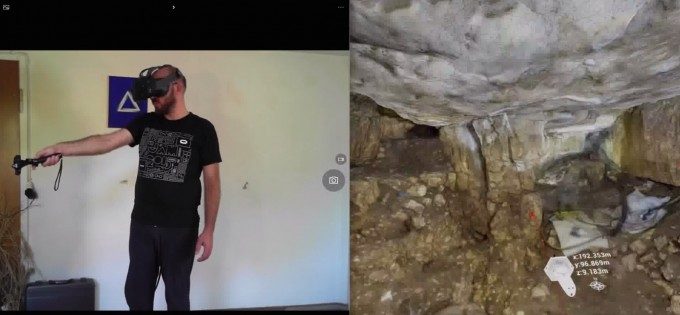Realities.IO is a company specialising in the scanning and visualisation of archeological sites of interest. The company is using their detailed scanning data to recreate those sites in room-scale VR, courtesy of the HTC Vive.
This new video demonstrates the potential power virtual reality has for transforming education. Archaeology is hardly one of the sexier sciences out there, but imagine how engaged a normally disinterested and hostile classroom would be if you offered them the chance to visit dig sites all around the world and explore them for themselves?
That’s the premise that struck me whilst watching the latest video from developer David Finsterwalder, founder of Realities.IO and specialist in photogrammetry, in particular in the field of cultural heritage. You may already know his work, as he produced one of the more innovative applications for this year’s Gear VR Mobile Jam, Castle VRuin – a title which featured a photorealistic recreation of Castle Hohenrechberg in Germany, allowing you to explore the site from the air or at ground level.
Finsterwalder has now released a proof of concept video which leverages the room-scale prowess of the HTC Vive VR system and a photogrammatic capture of a cave somewhere in Burgundy, France.
The demo was built using a 3D photo-scan of the Palaeolithic excavation and taps information from a databases with over 17,000 archeological entries from digs spanning 10 years. That data is presented as selectable points of interest overlaid onto the terrain.
Finsterwalder has some interesting observations on how he felt the scenes should best be rendered. “The (Photo)scan of the Cave itself is an unlit model. This is because delighting and baking Lightmaps afterwards doesn’t make much sense for real world scenes (as the scans are not intended to be “reusable assets” like you would create for a game),” he says, “Unlit Models also have the advantage that they aren’t costly to render and more GPU power can be utilized to create more detailed geometry (This is CRUCIAL for VR as stuff like normal maps look flat and Parallax Mapping only works well on flat surfaces).”
The developer also adopted a post processing technique known as tone-mapping, which attempts to emulate a high dynamic range, the resulting effect being a more pleasing, realistic colorisation.
The demo was built in roughly a week, on an HTC Vive Developer Edition Finsterwalder would normally never have considered applying for. “Someone at Valve who like my VR Jam entry [Castle VRuin] and wrote me an email suggesting to sign up for Dev Kit – which i didn’t do before, because I never expected to get one!” he says, commenting on Reddit.
According to Finsterwalder, a full video in collaboration with the University for Palaeolithic excavation will probably follow around November.







